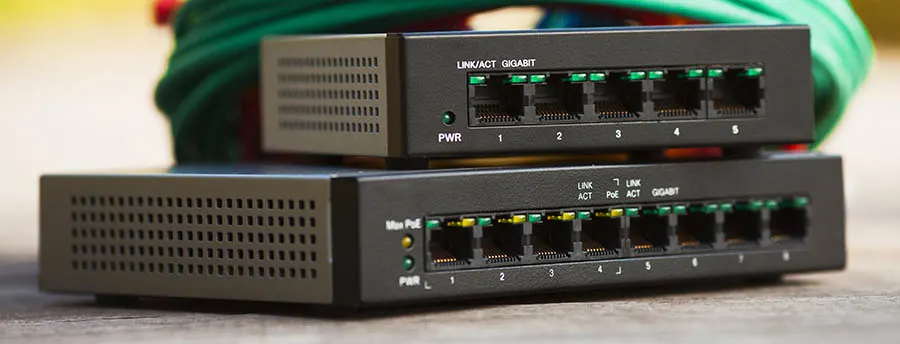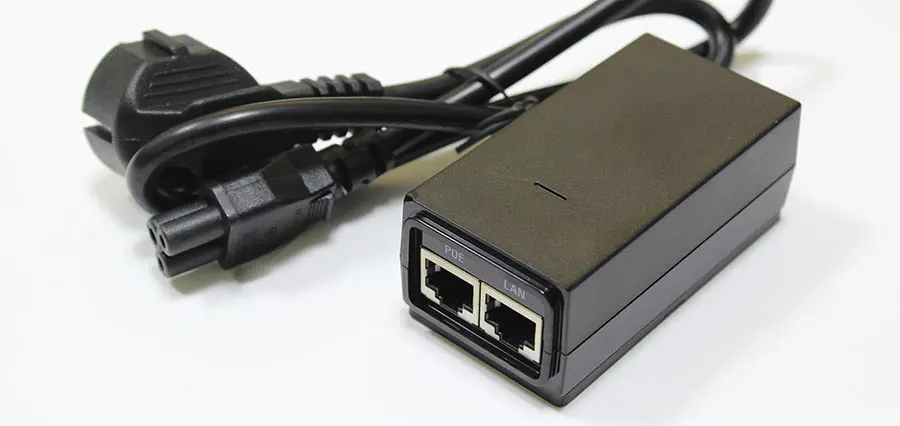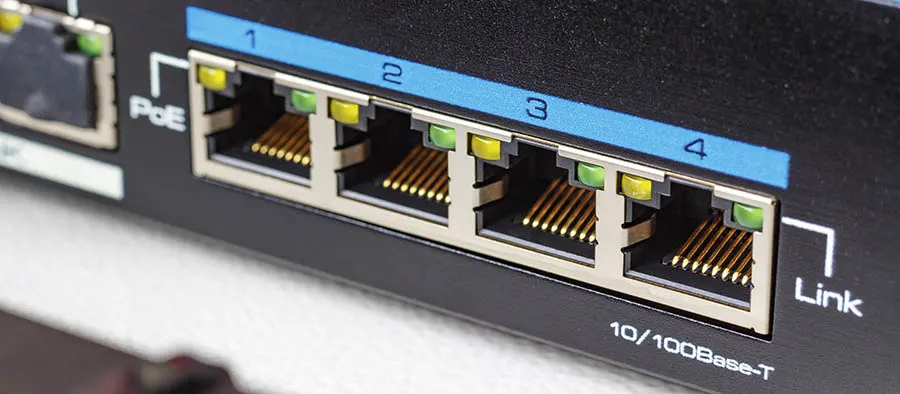Power over Ethernet, or PoE, is one of the coolest and handiest innovations among Ethernet network developments in recent years. It simplifies installations by bringing both power and data together into one cable, evoking the old phrase, “plug-n-play.” Like all evolving technologies, however, there are a lot of options to choose from, in addition to sets of changing standards to take into consideration.
The primary difference between a PoE injector and a PoE switch is that the injector provides a PoE signal along only one Ethernet cable run, whereas a PoE switch offers multiple PoE ports. They are different tools designed for different use cases.
Both PoE switches and Injectors can be passive or active, and in the case of active systems, both devices can vary in terms of the amount of voltage they provide. The most important factors to consider when choosing between an injector and a switch, are whether you intend on having more PoE devices in the future, how easy they are to install, and the price.
What Are PoE Switches?

PoE, and PoE switches, were initially developed to support the expanding demand for security camera systems. The intention was to speed and simplify the installation of multiple cameras by providing power as well as data over a single cable run while maintaining both internet and server connectivity, and the two spare pairs in Cat5 Ethernet cable were expressly available for just such a purpose.
The innovation quickly found its value for VoIP phone systems, and the number and quality of PoE applications continue to grow as a result. Ethernet switches, such as the BV-Tech 6-Port on Amazon, are devices that distribute the data transmitted and received via an Ethernet network connection.
They have multiple I/O ports, handle at least two unique IP addresses, and vary in size and port number. Routers, by comparison, are what we find more commonly in our homes, which act like small switches that accommodate only one IP address and fewer ports. PoE switches provide DC power along one or more of their Ethernet ports.
They can vary significantly in size, configuration, and power transmission mode. Not all of the ports of a PoE switch may supply PoE, and the PoE switch itself may have a maximum amount of total power it can provide, in turn limiting the number of connected devices it can power (more on PoE configurations in our guide). There are PoE switches with many ports, capable of expansion, which offer the possibility of extending the number of connected PoE devices later on.
Larger PoE switches can also utilize longer cable runs with their increased power. The primary purpose of PoE switches is to deliver voltage to multiple PoE receptive devices within a local area network. If your planned PoE system may require additional ports for future expansion, a PoE switch, like NETGEAR’s 8-Port Switch (on Amazon), is likely a wise option.
What Are PoE Injectors?

A kind of single-port PoE switch, Injectors offer PoE along only one cable and are meant to add the power component to a network cable that doesn’t have it built in. Like PoE switches, they can be passive or active, and vary in the amounts of DC power they transmit. They’re generally placed just after an Ethernet switch or router, inserted at the furthest point away from the device to be powered by PoE.
They have one Ethernet port input for unpowered Ethernet and an Ethernet port for outputting the PoE signal. Additionally, they have an input for the power source. Like PoE switches, there is a wide amount of variation between brands of Injectors, differing in size, quality of manufacture, cost, power input, and voltage output.
Unlike PoE switches, however, the scope of PoE provided by an Injector is always limited to one Ethernet port. Injectors, especially ones like the Cudy PoE300 (on Amazon), are way simpler and smaller than PoE switches, and while their scope of application is limited, they are considerably easier to install. An important factor with Injectors is to match their available PoE voltage to the device they are intended to power.
For an active injector, this simply means making sure the maximum deliverable voltage is equal to or more than what’s required by the target device. For a passive Injector, the deliverable voltage must be within the working limits of the device, and the reason for this is that you don’t want to deliver too much power to a device, because it may wind up damaging it.
Understanding PoE Basics
In a standard Ethernet cable, there are four pairs of wires. Pedestrian-style 10/100baseTx uses only two of these pairs to transmit data, leaving the other two pairs free to pass – in the case of PoE – DC electricity. Passive PoE systems exclusively use this style of power transmission method, called Mode B.
As demands on the internet have evolved, and larger bandwidth needs have expanded, two additional methods of transmitting both data and power over the four-wire pairs have been developed: Mode A and 4 Pair. Active PoE systems have been developed to accommodate these additional modes.
More importantly, active systems also communicate with their connected devices to assure that the correct power mode and amount of power are being transmitted, using a protocol called a Handshake. This is an important feature and can help to prevent damage from occurring to connected, non-PoE compatible equipment.
PoE – Passive vs. Active

What Is Passive PoE?
Before investing money and time into a PoE system of any kind, it’s important to understand the distinction between passive and active PoE systems. Passive PoE is, perhaps obviously, the more basic of the two. Passive PoE systems only utilize the power transmission method of Mode B, and as such will not power attached devices that utilize either of the two alternative modes.
Generally, they are limited to a maximum power output per port of 24V. Most importantly, passive PoE systems do not use a Handshake protocol, which means they cannot communicate with their attached devices. They simply project voltage along with their PoE-enabled ports to whatever device is attached on the opposite end of the Ethernet cable, without limiting or controlling the amount of power in any way.
What is Active PoE?
Active PoE systems by contrast, are able to utilize all three modes of power transmission. They often provide up to 48V along each Ethernet port, allowing for more kinds of connected devices as well as longer runs of Ethernet cable. Active PoE systems also, by definition, communicate with any attached device via a Handshake, and if a non-PoE compatible device is discovered, the supplied voltage for that Ethernet port is deactivated.
Finally, active PoE systems adhere to one of three IEEE standards: 802.3af, 802.3at, and 802.3bt. These are referred to commercially as PoE, PoE+, and PoE++, and the standard that applies to the active Injector or PoE switch in question will be clearly marked. Passive systems do not adhere to PoE+ or PoE++, and may not have any indication of IEEE adherence.
The distinction between active and passive PoE systems is relevant to any PoE installation, additionally, it’s crucial to understand the implications of them when connecting non-PoE devices (our guide) to the PoE network. If a non-PoE device is connected to a passive PoE network, it’s quite possible that the connected device will not receive the transmitted power properly. In other words, you could damage the device by supplying it with too much power.
When to Use a Switch or Injector?
When considering adding PoE to a currently existing network, or when building a PoE system from scratch, it’s important to identify the end goal of your PoE system. As novel and helpful an innovation like PoE is, there are some devilish details to both consider and understand. As we talked about in our PoE and safety article, alongside factoring in cost and installation concerns, ensuring that your valuable Ethernet-utilizing equipment can connect to your PoE system safely will make the best of your investment, and ensure your peace of mind.
Injectors Are Simpler
The simplest method for adding PoE to one or a few Ethernet devices is via an Injector. Particularly if you have a functioning LAN without PoE, Injectors are the easiest method to enable PoE without a larger-scale change of the Ethernet switch. The simplest injectors are passive and deliver a clear amount of DC power that can be easily matched to your PoE device (more on those in our guide).
Active PoE Injectors would be a better option if the power demands of your PoE device are not known. As we discussed before, active PoE devices communicate with each other to ensure the proper amount of power is supplied and received. Additionally, if that same device might be intermittently connected and disconnected, or if a non-PoE device might be attached to that same cable, then an injector is likely a better option.
PoE Switches Are More Versatile
If your system requires multiple devices to be connected via PoE, or if you’re intending to expand the number of your PoE devices in the future, then a PoE switch is likely a better option. Keep in mind the limitations of passive PoE switches which we’ve talked about before, and consider the number of PoE ports you might require.
